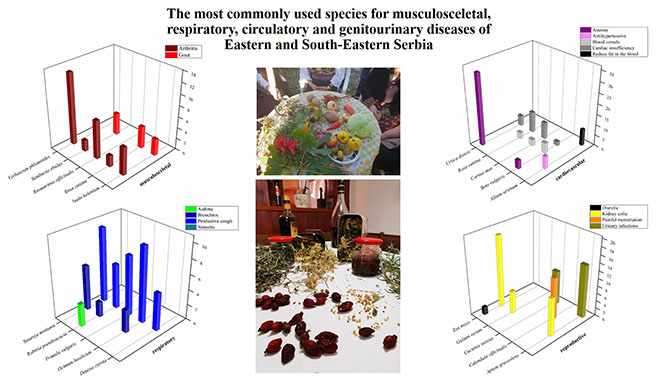JOURNAL 2861
Records of Natural Products
Year: 2024 Issue: 1 January-February
p.1 - 52
Viewed 492 times.
-
Jelena Matejic

-
Anđela Dragićević

-
Miloš Jovanović

-
Lazar D. Žarković

-
Ana M. Džamić

-
Snežana Hinić

-
Dragana Pavlović

GRAPHICAL ABSTRACT

ABSTRACT
Eastern and south-eastern Serbia is a cultural crossroads between East and West, and due to its economic underdevelopment, the traditional use of medicinal plants remains crucial in healthcare even today. This study aimed to collect and preserve ethnopharmacological knowledge about musculoskeletal, respiratory, circulatory, and genitourinary disorders, which are common in the local population. Information was collected using semi-structured anonymous ethnobotanical interviews with location informants. According to respondents, monographs of official international authorities (European Pharmacopoeia, ESCOP, WHO, EMA, and PDR) have been reviewed to confirm the traditional use of medicinal plants. Out of a total of 161 respondents, 58 (36%) declared that they use plants to treat musculoskeletal diseases, 147 (91.3%) to treat respiratory diseases, 113 (70.19%) to treat circulatory diseases, and 25 (15.53%) to treat genitourinary diseases. Among the plants that are traditionally used for the treatment of diseases of these organ systems, the following are highlighted for future research: Verbascum phlomoides, Inula helenium, and Rosmarinus officinalis for musculoskeletal; Ocimum basilicum, Robinia pseudoacacia and Primula vulgaris for respiratory; Urtica dioica, Allium ursinum, and Rosa canina for circulatory and Apium graveolens, Zea mays and Calendula officinalis for treatment of genitourinary system.
KEYWORDS- Ethnopharmacological study
- Balkan region
- musculoskeletal
- respiratory
- circulatory
- genitourinary disorders